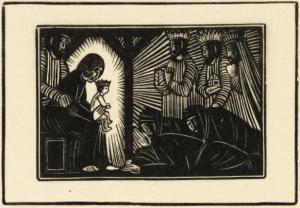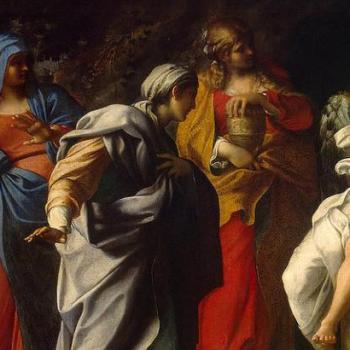On the church calendar the season after Christmas is called Epiphany. “Epiphany” is not a word we use very often these days.
The word has two meanings. First, epiphany can mean “an appearance or manifestation of God.” This kind of epiphany is sometimes called a theophany, which literally means God-appearance. So when we observe the Epiphany season, we celebrate God appearing to us in the person of Jesus. (The actual day of Epiphany, January 6, commemorates Jesus being presented to the Magi, or wise men, from the East.)

The Old Testament records a number of epiphanies, or theophanies, from YHWH to the people of Israel. So, for example, we read from 1 Samuel of the young Samuel receiving an epiphany from YHWH. God calls to Samuel in the night, but Samuel thinks it is his adoptive father, the prophet Eli. This happens three times until Eli realizes it is YHWH and instructs Samuel to reply, “Speak, [YHWH], your servant is listening.” So when YHWH calls Samuel a fourth time, Samuel replies as he had been instructed: “Speak, your servant is listening.”
Second, epiphany can mean “a moment of sudden insight or understanding.” This kind of epiphany might also be called “eureka!” moment. Legend has is that one day the ancient Greek mathematician Archimedes (ark-uh-mee-deez) stepped into a bath and noticed that the water around him rose. He suddenly realize that the volume of water displaced in the tub was equal to the volume of the part of his body submerged in the water. This realization immediately solved a math problem that had never before been solved—namely, how to measure the volume of an irregular shaped object, like a human body.
Apparently he was so excited that he shouted “Eureka! Eureka!” And then he jumped out of the tub and ran naked through the streets of Syracuse, telling everyone of his math discovery. (Archimedes may have been the first—but he certainly wasn’t the last—to have a eureka moment while bathing. Fortunately most of us wait until we’re fully clothed to share them with others.)
“Eureka!”
“It just hit me!”
“Aha!”
“I’ve got it!”
All of these exclamations are ways of exclaiming, “I’ve just had an epiphany!”
There’s excitement when you have an epiphany. There’s joy when you’re suddenly struck by a profound insight. This is especially so when, like Archimedes, it’s about something you’ve been trying to figure out for a long time, but the answer has always eluded you.
This morning’s story from John’s Gospel suggests that the two meanings of the word “epiphany” are related. The big idea from the story is this: When we encounter God in Jesus, we see reality differently.
A theophany leads to a “eureka!” moment.
An epiphany creates an epiphany!
Let’s look again John 1.
If we back up to the beginning of John, we will notice that Jesus’s encounter with Nathanael is the last of four epiphanies described in this chapter.
John begins with the great prologue: “In the beginning the Word already existed. The Word was with God, and the Word was God” (John 1:1). John identifies Jesus as the very Word of God and, indeed, with God’s own being. He then switches from the metaphor of speech to the metaphor of sight. This Word, Jesus, is also the Light. So verse 5 states that Jesus is “the light [that] shines in the darkness.”
So God sends John the Baptist “to tell about the light so that everyone might believe because of his testimony” (v. 7). For, as verse 18 declares, “No one has ever seen God. But the unique One, who is himself God, is near to the Father’s heart. He has revealed God to us.”
This prologue gives us all the pieces to understand the narrative: Though the world is created by the Word of God, the world is in darkness and cannot see God. God sends his Word into the world to be a light to the world so that the world can see God. That light is testified to by witnesses—those who have encountered the light and call others into the light.
The narrative of John begins in verse 19 with John the Baptist testifying to his people about the light that is about to appear. In verse 29 John the Baptist sees Jesus and tells his followers, “Look! The Lamb of God who takes away the sin of the world!” He recounts how he saw the Holy Spirit come down from heaven as a dove and remain on Jesus. Then in verse 34 he concludes, “I saw this happen to Jesus, so I testify that he is the Chosen One of God.”
John the Baptist experienced an epiphany, and he testifies about it to others. So in verse 36 he tells two of his disciples, “Look! There is the Lamb of God!” These two disciples of John the Baptist then become disciples of Jesus.
One of them, Andrew, runs and finds his brother, Simon, and testifies to him, “We’ve found the Messiah” (v. 41). So Simon, whom Jesus calls Peter, joins his brother Andrew as a disciple.
And that leads to this morning’s reading. In verse 43, Jesus finds Philip—who is from the same town as Andrew and Peter—and calls him to be a disciple. Philip then runs off and finds his buddy Nathanael. Just as John the Baptist had testified to Andrew, and Andrew has testified to Simon Peter, so now Philip testifies to Nathanael in verse 45: “We have found the very person Moses and the prophets wrote about! His name is Jesus, the son of Joseph from Nazareth.”
But now we encounter the first roadblock in this succession of testimonies and conversions. Unlike Andrew, Simon, and Philip, who are all from the town of Bethsaida on the far northeast side of the Sea of Galilee, Nathanael is a westsider. He’s from the town of Cana, which is just a couple miles from the small town of Nazareth, which is also on the west side. So when he hears his buddy Philip breathlessly declaring that they found the long-awaited Messiah in the little, podunk town of Nazareth, he is incredulous.
“Nazareth!” he responds. “Can anything good come from Nazareth?” (v. 46).
Nazareth isn’t mentioned anywhere in the Hebrew Scriptures. There’s no prophecy declaring that the Messiah will come from there. It’s such an insignificant town that there’s no known record of it anywhere outside the Gospels and the book of Acts until around 150 years later. Archaeologists and historians think it probably had a population of about 400 people. And so we can probably sympathize with Nathanael’s dismissive question about the town. (This is just how people in the bars of Cana spoke about Nazareth.)
Philip doesn’t try to argue with Nathanael. He doesn’t give him an apologetics seminar about how Hebrew prophecy proves that Jesus must be the Messiah. He simply invites Nathanael, “Come and see for yourself” (v. 46).
Then there’s another twist. Before Nathanael sees Jesus, Jesus sees him. Jesus calls out, “Now here is a genuine son of Israel—a man of complete integrity” (v. 47).
Nathanael is taken aback. “How do you know about me?” he asks (v. 48).
Jesus responds with what seems to be a pretty straightforward answer: “I could see you under the fig tree before Philip found you” (v. 48).
For some reason—that’s not entirely clear to the reader—this answer strikes Nathanael hard. Or perhaps it’s not so much the answer as the one who gives it. But for whatever reason, Nathanael has a sudden epiphany. He goes from doubting that anything good, much less the Messiah himself, could come from Nazareth to immediately declaring to Jesus: “Rabbi, you are the Son of God—the King of Israel!” (v. 49).
Nathanael’s confession goes beyond what even Philip had told Nathanael of Jesus. Philip had said they found the Messiah, but Nathanael has had an epiphany.
He has encountered the Son of God.
The Word who became flesh.
The light who brings light.
God the One and Only.
Jesus seems almost a little amused by Nathanael’s stunning reversal. “Do you believe this just because I told you I had seen you under the fig tree?” Jesus responds. “You will see greater things than this” (v. 50).
He then turns to all the disciples who have witnessed this encounter: “I tell you the truth, you will all see heaven open and the angels of God going up and down on the Son of Man, the one who is the stairway between heaven and earth” (v. 51).
This image sounds strange to us, but it would have been perfectly understandable to his disciples, especially Nathanael, whom Jesus had just called “a genuine son of Israel.”
In Genesis 28, the patriarch Jacob, whose name is later changed to Israel, has a dream. In this dream he sees a ladder stretching from earth to heaven, and on the ladder Jacob sees angels of God ascending and descending. Beside the ladder, Jacob sees YHWH, who declares, “I am [YHWH], the God of your grandfather Abraham, and the God of your father, Isaac” (v. 13).
Jacob experienced a theophany.
And so when he awakes, he has an epiphany.
“Surely [YHWH] is in this place,” he says, “and I wasn’t aware of it” (v. 16). He continues, “What an awesome place this is! It is none other than the house of God, the very gateway to heaven” (v. 17). And so he names the place Bethel, meaning house of God.
When Jesus tells Philip, Andrew, Simon Peter, and Nathanael that they will “see heaven open and the angels of God going up and down on the Son of Man, the one who is the stairway between heaven and earth,” he is declaring that he is the gateway to heaven.
He is Bethel, the house of God.
In Jesus “lives all the fullness of God in a human body,” as Paul writes to the Colossians (Col. 2:9).
That means that when we see Jesus, we see God.
We experience an epiphany, a theophany.
And this leads to an epiphany, a eureka!
This sermon was first preached at Keller Park Church in South Bend, Indiana. All Scripture quotations, unless otherwise noted, are from the New Living Translation (NLT).












